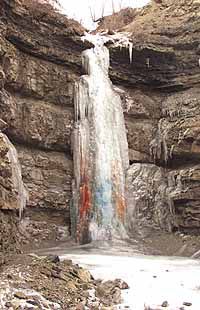| The scenic waterfall created by melting snow and underground sources captures the attention of all motorists traveling through Price Canyon on U.S. Highway 6. But with Carbon County entering the fourth consecutive year of drought conditions, substandard snow levels and the overall lack of precipitation may dry up the natural scenic attraction. The entire state faces a drought and officials encourage residents at locations throughout Utah to focus on implementing conservation methods. Experts, appointed officials and elected representatives recently met at the Utah Capitol to discuss the state’s water shortage and develop recommendations to promote immediate conservation efforts. |
With Carbon County and the state entering a fourth consecutive drought year, officials encourage all Utahns to implement conservation methods.
Experts recently met to discuss the state’s water shortage and develop recommendations to promote immediate conservation efforts statewide.
“When I was made aware that Utah would experience a drought for the fourth year in a row, I thought it would be worthwhile to bring the experts together and discuss the drought,” pointed out Rep. Carl Saunders.
The Orem lawmaker hosted the gathering. Presenters included Utah Division of Water Resources director Larry Anderson and state climatologist Don Jensen.
“Our goal is to get the people of Utah to realize that we live in a desert and we need to conserve water,” indicated Anderson, who serves as the director of the state’s climate center. “We not only need to conserve water because we are in a drought, but we need to conserve water because it is the right thing to do.”
Utah leaders plan to continue a program initiated last fall and actively promote the statewide conservation campaign.
“We do have a drought going on,” confirmed Jensen. “The further south and the higher in the mountains you go, the more severe the drought is.”
Storage reservoirs in Utah are designed to supply local communities with water for two years, according to the climatologist and state division director. With prior management measures, state agencies and local districts have spread reservoir storage to accommodate public demand for three years.
Utah is the second driest state in the nation, but reports one of the highest water consumption rates. Data compiled by the state agencies indicate Utahns use 321 gallons of water per capita per day.
By comparison, average consumption in the mountain states registers at 245 gpcd and nationwide at 179 gpcd. Only Nevada uses more water than Utah.
By 2035, Utah is projected to have four million residents. Meeting the needs of the expanding population requires wise residential, agricultural and commercial water consumption, stressed the state agencies.
Approximately 61 percent of all residential water is utilized outdoors, indicates the department of natural resources. Uses include hosing driveways, washing vehicles and watering landscapes.
Remaining residential water consumption totals include 16 percent for toilets, 13 percent for bathing/bathrooms, 4 percent in kitchens/dishwashers and 6 percent for laundry purposes.
Residents consume more culinary water during the summer when it rains the least. The demand not only strains, but outpaces the current supplies.
Delivering water costs millions of dollars and prices are escalating. But conservation represents the least expensive alternative for Utah consumers, emphasized the department of natural resources.
Due to the substandard snowpack levels in the mountains surrounding Castle Valley, the agency stresses the importance for Carbon and Emery citizens to adhere to several conservation practices. The recommendations include:
•Properly design new landscapes with low water plants and trees.
•Water lawns between 8 p.m. and 8 a.m. Aerate to allow water to soak freely into the ground.
•Adjust schedules as the weather changes to avoid overwatering.
•Water areas containing lawns, plants, gardens or trees – not empty patches of ground.
•Mulch planting beds to minimize evaporation.
•Attach shut-off nozzles to hoses when washing vehicles, farming or landscaping equipment.
•Clean driveways and sidewalks with brooms or vacuums instead ofhoses.
•Promptly fix leaks in residential water systems, including dripping faucets.
•Install efficient plumbing fixtures when constructing new homes and businesses. Consider replacing inefficient plumbing fixtures in older structures.

